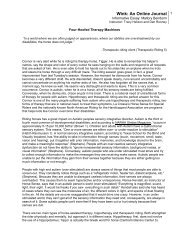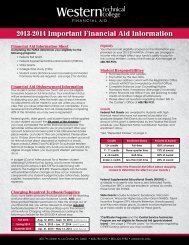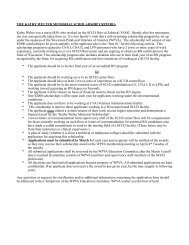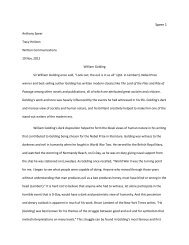The History of Western Technical College
The History of Western Technical College
The History of Western Technical College
Create successful ePaper yourself
Turn your PDF publications into a flip-book with our unique Google optimized e-Paper software.
<strong>The</strong> 1920’s<br />
In 1920, one floor <strong>of</strong> the Longfellow School at Sixth and Vine Streets collapsed, dropping several thousand feet <strong>of</strong><br />
lumber and a number <strong>of</strong> students to the second floor. During the remodeling, vocational classes were held in various<br />
public buildings such as the Trades and Labor Hall (that was housed in the Tausche Hardware building at 415 Jay Street<br />
in La Crosse.) At that time, business education, home making, woodworking, printing and machine shop were <strong>of</strong>fered.<br />
<strong>The</strong> first recorded graduate apprentices were: Edward Bock, a baker apprentice employed by the Jackson Street Bakery<br />
(at 1415 Jackson Street) who graduated on May 19, 1920, and Clifford Hawkins, a bread baker employed by the Rupplin<br />
Baking Company (at 412 South Fourth Street) who graduated September 2, 1920. <strong>The</strong> Chicago, Burlington and Quincy<br />
Railroad Company in La Crosse employed three machine apprentices. <strong>The</strong>y were Earl J. Keizer, who graduated February<br />
28, 1921; William Coughlin, who graduated March 19, 1921; and Harry T. Hammersberg, who graduated August 1,<br />
1921.<br />
On February 17, 1922, a fire alarm in the Vocational School building sounded at 7:55 p.m. followed by a 3-11 alarm at<br />
7:59 p.m. <strong>The</strong> fire originated in the basement and spread to two floors and into the attic <strong>of</strong> the building. <strong>The</strong> fire<br />
department indicated that the fire originated in the boiler room. Both floors in the east section <strong>of</strong> the building caved in<br />
as a result <strong>of</strong> the fire and the heavy equipment placed upon them. <strong>The</strong> flames charred considerable woodwork<br />
throughout the entire building, as was the attic and the west ro<strong>of</strong>. After viewing the damage, the Board <strong>of</strong> Education<br />
declared that the Longfellow School would be repaired and continued to be used for school purposes.<br />
<strong>The</strong> La Crosse Tribune coverage on the fire printed, "Oh Skinnay! - <strong>The</strong> cherished desire <strong>of</strong> kids for many generations,<br />
the rosy dream that someday the school house would burn down and school would be out indefinitely, is to be realized<br />
for at least a little while .. . there are 575 pupils in the day classes . . . and 1,293 in various evening classes which will<br />
continue to meet at the High School (16 th and Cass Streets)." A temporary <strong>of</strong>fice was established in a residence at 610<br />
Pine Street, and it was anticipated that the Hogan (18 th and Winnebago Streets), Lincoln (at 8 th and Division Streets),<br />
Washington (then located at 16 th and Vine Streets) and other schools would accommodate vocational classes. Subjects<br />
taught at that time included business education, homemaking, woodworking, printing and machine shop.<br />
In a communique from Director John B. Coleman, "Beginning Monday, October 9, 1922, the boys were segregated from<br />
the girls in all phases <strong>of</strong> our day work ... we have at present 161 girls and 122 boys enrolled in our day school, and<br />
through the excellent cooperation <strong>of</strong> the public school principals, we are enabled to add a few to our list each day . . .<br />
We have at the present time 25 instructors employed and are <strong>of</strong>fering 25 subjects. We are requiring our Evening School<br />
pupils to make a deposit <strong>of</strong> one dollar, which we call an enrollment fee, and which is returned at the end <strong>of</strong> the year,<br />
providing the person has been present three-fourths <strong>of</strong> the time . . . This scheme has not been used before in La<br />
Crosse, and thus far, it has met with no opposition . . .it is going to help us overcome the difficulty that they have had<br />
here in the past <strong>of</strong> holding their Evening School pupils throughout the entire session."<br />
Following the destruction <strong>of</strong> the Longfellow School by fire in 1922, plans were laid before the La Crosse Common<br />
Council for the construction <strong>of</strong> a city vocational education building on the same site. Work was begun on the new<br />
institution late in 1923 following an appropriation <strong>of</strong> over $200,000 from the La Crosse Common Council and was ready<br />
for occupancy on Tuesday, September 2, 1924. During construction, regular school classes were held in the Central<br />
High School (16* and Cass Streets) and in the barracks on the Washburn school campus (8 th and State Streets) and that<br />
arrangement lasted until September 1924 when construction was completed.<br />
Interest in the La Crosse Vocational School was gaining statewide attention. Vocational directors from Fond du Lac and<br />
Green Bay met with Director Coleman to gain insight about the system and its ways <strong>of</strong> conducting classes. Nowhere<br />
else in the state was a school being conducted so successfully and at no other place were the directors working under<br />
the disadvantages <strong>of</strong> the La Crosse Vocational School with its barrack rooms and its work divided into three centers<br />
awaiting the completion <strong>of</strong> the new building.<br />
<strong>The</strong> new Vocational School covered one-half square block with a second story portion along Vine Street. A distinct<br />
feature <strong>of</strong> the new vocational school was the segregation <strong>of</strong> boys and girls in classrooms and shops arranged in "L"<br />
shape. <strong>The</strong> girls followed the front <strong>of</strong> the building on Sixth Street extending to the east doorway on Vine Street. <strong>The</strong><br />
boys "L" was on the east and north sides <strong>of</strong> the building. Boys and girls had separate entrances—the girls' door being<br />
near the corner <strong>of</strong> Vine Street and the boys' entrance near the alley on Vine Street. <strong>The</strong> new school opened for the<br />
1924 term with 10 day school teachers and 51 evening school teachers.

















